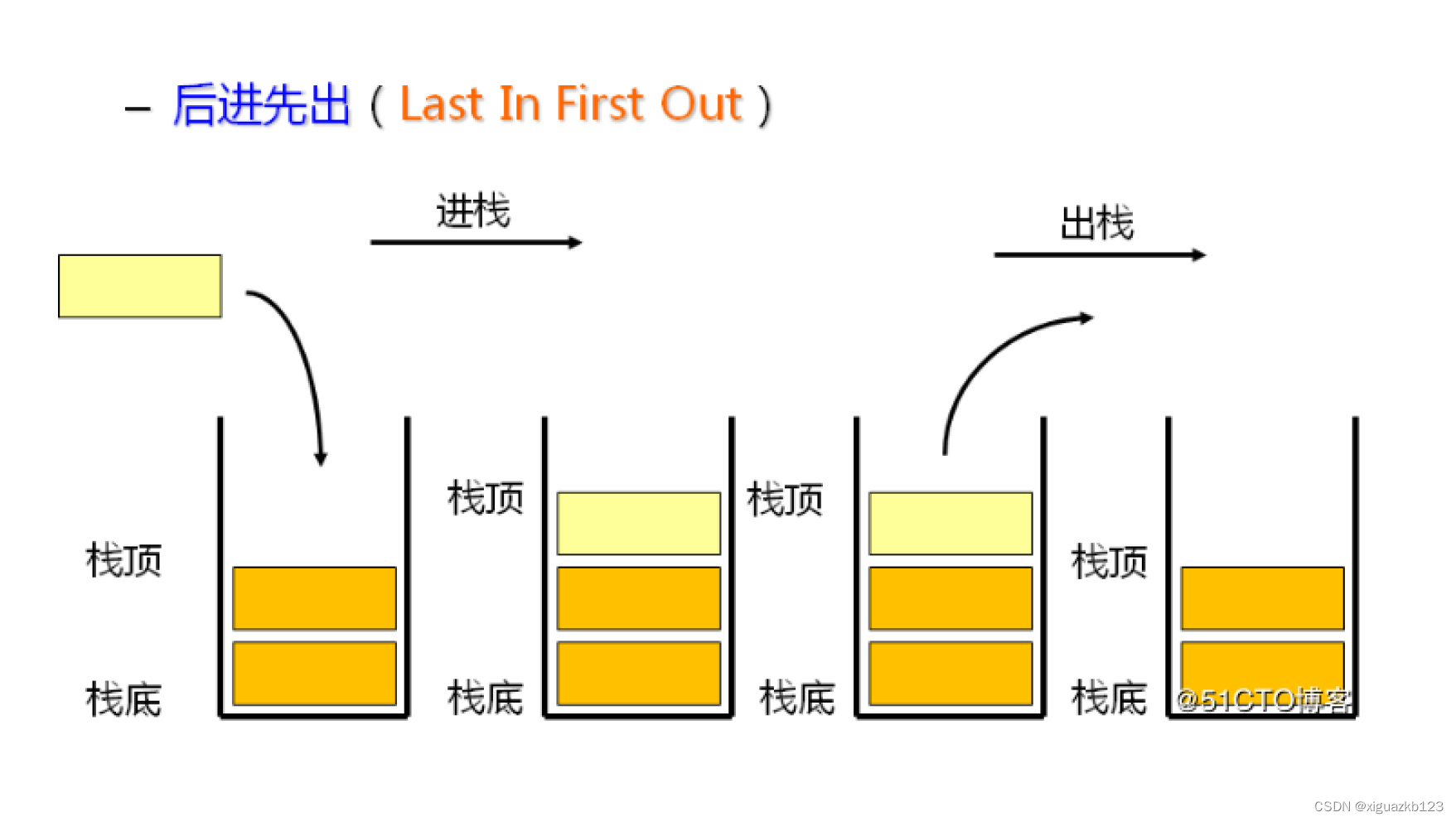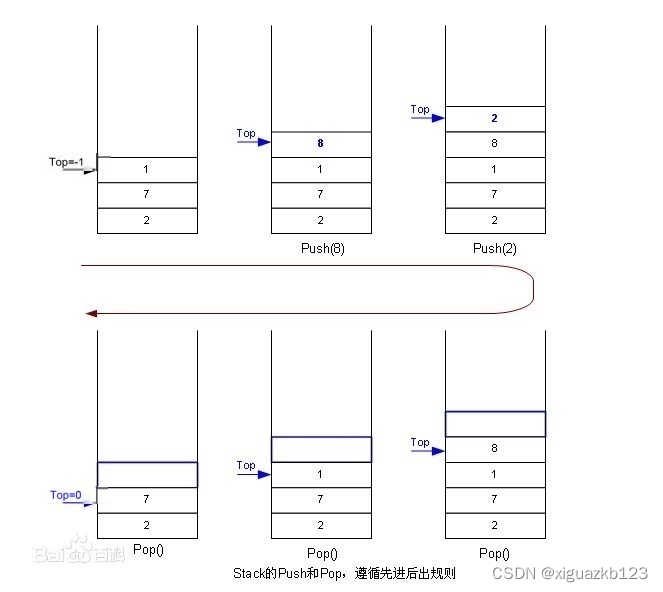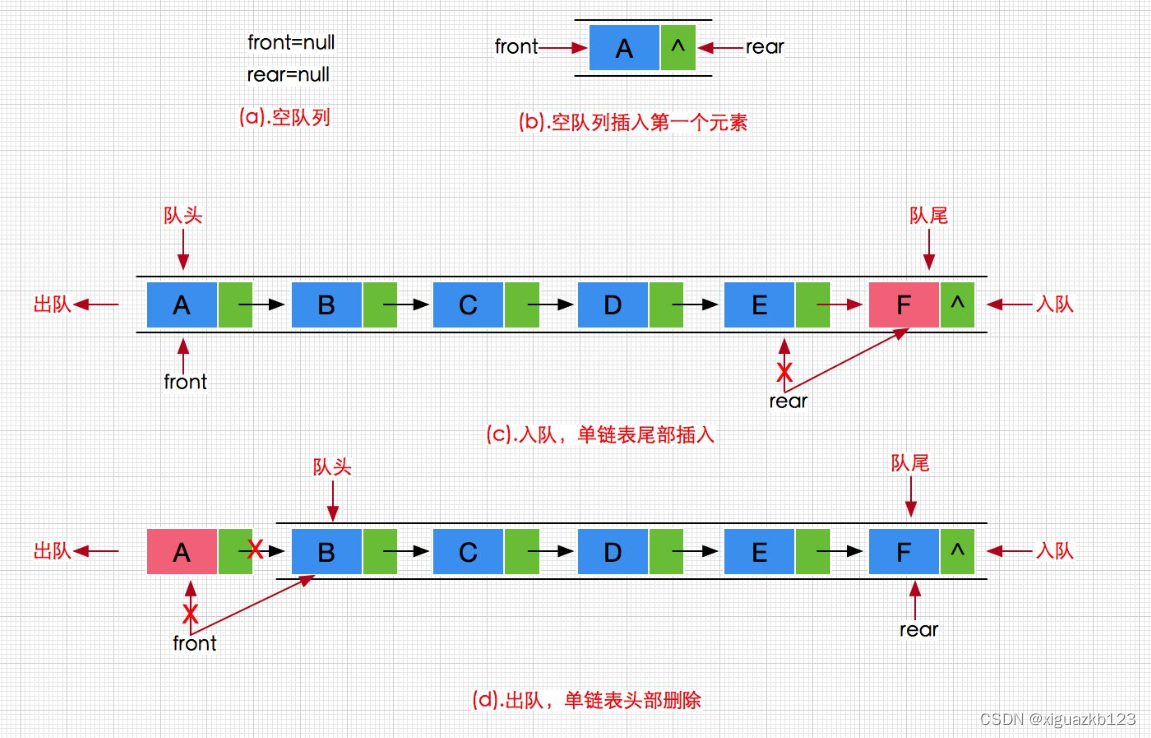目录
1.栈
1.1栈的概念及结构
栈:一种特殊的线性表,其只允许在固定的一端进行插入和删除元素操作。进行数据插入和删除操作的一端 称为栈顶,另一端称为栈底。栈中的数据元素遵守后进先出LIFO(Last In First Out)的原则。
压栈:栈的插入操作叫做进栈/压栈/入栈,入数据在栈顶。
出栈:栈的删除操作叫做出栈。出数据也在栈顶


可以使用数组(数组栈)或者链表(链表栈)实现栈。
数组栈实现更优一些。因为数组栈 尾插尾删效率更高,且缓存利用率高。
单链表,适合头插头删,如果用头作栈顶,可以设计成单链表,但是有点怪。用尾作栈底,要设计成双向链表,否则增删数据效率低。
1.2栈的实现
栈的实现一般可以使用数组或者链表实现,相对而言数组的结构实现更优一些。因为数组在尾上插入数据的 代价比较小。
#define _CRT_SECURE_NO_WARNINGS 1
#include <stdio.h>
#include <assert.h>
#include <stdlib.h>
#include <stdbool.h>
typedef int STDataType;
typedef struct Stack
{
STDataType* a;
int top;
int capacity;
}ST;
// 初始化栈
void StackInit(ST* ps);
//栈空间检查
void StackCheckCapacity(ST* ps);
// 销毁栈
void StackDestroy(ST* ps);
// 入栈
void StackPush(ST* ps, STDataType x);
// 出栈
void StackPop(ST* ps);
// 获取栈顶元素
STDataType StackTop(ST* ps);
// 获取栈中有效元素个数
int StackSize(ST* ps);
// 检测栈是否为空,如果为空返回非零结果,如果不为空返回0
bool StackEmpty(ST* ps);
初始化栈
void StackInit(ST* ps)
{
assert(ps);
ps->a = NULL;
ps->top = ps->capacity = 0;//ps->top=-1;
}
销毁栈
void StackDestroy(ST* ps)
{
assert(ps);
free(ps->a);
ps->a = NULL;
ps->capacity = ps->top = 0;
}栈的扩容
void StackCheckCapacity(ST* ps)
{
assert(ps);
if (ps->top == ps->capacity)
{
int newCapacity = ps->capacity == 0 ? 4 : ps->capacity * 2;
STDataType* tmp = realloc(ps->a, sizeof(STDataType) * newCapacity);
if (tmp == NULL)
{
printf("realloc fail");
exit(-1);
}
ps->a = tmp;
ps->capacity = newCapacity;
}
}入栈
void StackPush(ST* ps, STDataType x)
{
assert(ps);
StackCheckCapacity(ps);
ps->a[ps->top] = x;
ps->top++;
}出栈
void StackPop(ST* ps)
{
assert(ps);
assert(!StackEmpty(ps));
ps->top--;
}获取栈顶元素
STDataType StackTop(ST* ps)
{
assert(ps);
assert(!StackEmpty(ps));
return ps->a[ps->top - 1];
}获取栈中有效元素个数
int StackSize(ST* ps)
{
assert(ps);
return ps->top;
}判空
// 检测栈是否为空,如果为空返回非零结果,如果不为空返回0
bool StackEmpty(ST* ps)
{
assert(ps);
/*if (ps->top == 0)
{
return true;
}
else
{
return false;
}*/
//换成下面语句就行了
return ps->top == 0;
}程序代码如下
Stack.h
#define _CRT_SECURE_NO_WARNINGS 1
#include <stdio.h>
#include <assert.h>
#include <stdlib.h>
#include <stdbool.h>
typedef int STDataType;
typedef struct Stack
{
STDataType* a;
int top;
int capacity;
}ST;
void StackInit(ST* ps);
void StackDestroy(ST* ps);
void StackPush(ST* ps, STDataType x);
void StackPop(ST* ps);
STDataType StackTop(ST* ps);
int StackSize(ST* ps);
bool StackEmpty(ST* ps);
Stack.c
#define _CRT_SECURE_NO_WARNINGS 1
#include"Stack.h"
void StackInit(ST* ps)
{
assert(ps);
ps->a = NULL;
ps->top = ps->capacity = 0;//ps->top=-1;
}
void StackDestroy(ST* ps)
{
assert(ps);
free(ps->a);
ps->a = NULL;
ps->capacity = ps->top = 0;
}
void StackCheckCapacity(ST* ps)
{
assert(ps);
if (ps->top == ps->capacity)
{
int newCapacity = ps->capacity == 0 ? 4 : ps->capacity * 2;
STDataType* tmp = realloc(ps->a, sizeof(STDataType) * newCapacity);
if (tmp == NULL)
{
printf("realloc fail");
exit(-1);
}
ps->a = tmp;
ps->capacity = newCapacity;
}
}
void StackPush(ST* ps, STDataType x)
{
assert(ps);
StackCheckCapacity(ps);
ps->a[ps->top] = x;
ps->top++;
}
void StackPop(ST* ps)
{
assert(ps);
assert(!StackEmpty(ps));
ps->top--;
}
STDataType StackTop(ST* ps)
{
assert(ps);
assert(!StackEmpty(ps));
return ps->a[ps->top - 1];
}
int StackSize(ST* ps)
{
assert(ps);
return ps->top;
}
bool StackEmpty(ST* ps)
{
assert(ps);
/*if (ps->top == 0)
{
return true;
}
else
{
return false;
}*/
//换成下面语句就行了
return ps->top == 0;
}
test.c
#define _CRT_SECURE_NO_WARNINGS 1
#include"Stack.h"
void test1()
{
ST st;
StackInit(&st);
StackPush(&st, 1);
StackPush(&st, 2);
StackPush(&st, 3);
StackPush(&st, 4);
printf("%d ", StackTop(&st));
StackPop(&st);
StackPop(&st);
StackPop(&st);
StackPop(&st);
//printf("%d ", StackTop(&st));
StackDestroy(&st);
}
int main()
{
test1();
return 0;
}2.队列
2.1队列的概念及结构
队列:只允许在一端进行插入数据操作,在另一端进行删除数据操作的特殊线性表,队列具有先进先出FIFO(First In First Out)
- 入队列:进行插入操作的一端称为队尾
- 出队列:进行删除操作的一端称为队头
 2.2队列的实现
2.2队列的实现
队列也可以数组和链表的结构实现,使用链表的结构实现更优一些,因为如果使用数组的结构,出队列在数组头上出数据,效率会比较低。

typedef int QDataType;
//链式结构:表示队列
typedef struct QueueNode
{
struct QueueNode* next;//指针域
QDataType data;//数据域
}QueueNode;
//队列链表的头指针与尾指针
typedef struct Queue
{
QueueNode* head;
QueueNode* tail;
}Queue;
//初始化队列
void QueueInit(Queue* pq);
//扩队
QueueNode* BuyQueueNode(QDataType x);
//队尾入队列
void QueuePush(Queue* pq, QDataType x);
//队头出队列
void QueuePop(Queue* pq);
//获取队列头部元素
QDataType QueueFront(Queue* pq);
//获取队列队尾元素
QDataType QueueBack(Queue* pq);
//获取队列中有效元素个数
int QueueSize(Queue* pq);
//队列打印
void QueuePrint(Queue* pq);
//队列判空
bool QueueEmpty(Queue* pq);
//销毁队列
void QueueDestroy(Queue* pq);
初始化队列
void QueueInit(Queue* pq)
{
assert(pq);
pq->head = NULL;
pq->tail = NULL;
}队尾入队列
void QueuePush(Queue* pq, QDataType x)
{
assert(pq);
QueueNode* newnode = BuyQueueNode(x);
if (pq->head == NULL)
{
pq->head = pq->tail = newnode;
}
else
{
pq->tail->next = newnode;
pq->tail = newnode;
}
}队头出队列
void QueuePop(Queue* pq)
{
assert(pq);
//if (pq->head == NULL)
// return;
assert(!QueueEmpty(pq));
QueueNode* next = pq->head->next;
free(pq->head);
pq->head = next;
if (pq->head == NULL)
{
pq->tail = NULL;
}
}获取队列头部元素
QDataType QueueFront(Queue* pq)
{
assert(pq);
assert(!QueueEmpty(pq));
return pq->head->data;
}获取队列队尾元素
QDataType QueueBack(Queue* pq)
{
assert(pq);
assert(!QueueEmpty(pq));
return pq->tail->data;
}获取队列中有效元素个数
int QueueSize(Queue* pq)
{
assert(pq);
int n = 0;
QueueNode* cur = pq->head;
while (cur)
{
++n;
cur = cur->next;
}
return n;
}队列打印
void QueuePrint(Queue* pq)
{
QueueNode* cur = pq->head;
while (cur)
{
printf("%d ", cur->data);
cur = cur->next;
}
printf("\n");
}队列判空
bool QueueEmpty(Queue* pq)
{
assert(pq);
return pq->head == NULL;
}销毁队列
void QueueDestroy(Queue* pq)
{
assert(pq);
QueueNode* cur = pq->head;// QueueNode* cur =NULL
while (cur != NULL)
{
QueueNode* next = cur->next;
free(cur);
cur = next;
}
pq->head = pq->tail = NULL;
}Queue.h
#pragma once
#include <stdio.h>
#include <assert.h>
#include <stdlib.h>
#include <stdbool.h>
typedef int QDataType;
//链式结构:表示队列
typedef struct QueueNode
{
struct QueueNode* next;//指针域
QDataType data;//数据域
}QueueNode;
//队列链表的头指针与尾指针
typedef struct Queue
{
QueueNode* head;
QueueNode* tail;
}Queue;
//初始化队列
void QueueInit(Queue* pq);
//扩队
QueueNode* BuyQueueNode(QDataType x);
//队尾入队列
void QueuePush(Queue* pq, QDataType x);
//队头出队列
void QueuePop(Queue* pq);
//获取队列头部元素
QDataType QueueFront(Queue* pq);
//获取队列队尾元素
QDataType QueueBack(Queue* pq);
//获取队列中有效元素个数
int QueueSize(Queue* pq);
//队列打印
void QueuePrint(Queue* pq);
//队列判空
bool QueueEmpty(Queue* pq);
//销毁队列
void QueueDestroy(Queue* pq);
Queue.c
#define _CRT_SECURE_NO_WARNINGS 1
#include"Queue.h"
void QueueInit(Queue* pq)
{
assert(pq);
pq->head = NULL;
pq->tail = NULL;
}
void QueueDestroy(Queue* pq)
{
assert(pq);
QueueNode* cur = pq->head;// QueueNode* cur =NULL
while (cur != NULL)
{
QueueNode* next = cur->next;
free(cur);
cur = next;
}
pq->head = pq->tail = NULL;
}
QueueNode* BuyQueueNode(QDataType x)
{
QueueNode* newnode = (QueueNode*)malloc(sizeof(QueueNode));
if (newnode == NULL)
{
printf("malloc fail\n");
exit(-1);
}
newnode->data = x;
newnode->next = NULL;
return newnode;
}
void QueuePush(Queue* pq, QDataType x)
{
assert(pq);
QueueNode* newnode = BuyQueueNode(x);
if (pq->head == NULL)
{
pq->head = pq->tail = newnode;
}
else
{
pq->tail->next = newnode;
pq->tail = newnode;
}
}
void QueuePrint(Queue* pq)
{
QueueNode* cur = pq->head;
while (cur)
{
printf("%d ", cur->data);
cur = cur->next;
}
printf("\n");
}
void QueuePop(Queue* pq)
{
assert(pq);
//if (pq->head == NULL)
// return;
assert(!QueueEmpty(pq));
QueueNode* next = pq->head->next;
free(pq->head);
pq->head = next;
if (pq->head == NULL)
{
pq->tail = NULL;
}
}
QDataType QueueFront(Queue* pq)
{
assert(pq);
assert(!QueueEmpty(pq));
return pq->head->data;
}
QDataType QueueBack(Queue* pq)
{
assert(pq);
assert(!QueueEmpty(pq));
return pq->tail->data;
}
int QueueSize(Queue* pq)
{
assert(pq);
int n = 0;
QueueNode* cur = pq->head;
while (cur)
{
++n;
cur = cur->next;
}
return n;
}
bool QueueEmpty(Queue* pq)
{
assert(pq);
return pq->head == NULL;
}test.c
#define _CRT_SECURE_NO_WARNINGS 1
#include"Queue.h"
void test1()
{
Queue q;
QueueInit(&q);
QueuePush(&q, 1);
QueuePush(&q, 2);
QueuePush(&q, 3);
QueuePush(&q, 4);
QueuePrint(&q);
/*QueuePop(&q);
QueuePop(&q);
QueuePop(&q);
QueuePop(&q);*/
QueuePrint(&q);
printf("%d\n", QueueFront(&q));
printf("%d\n", QueueBack(&q));
QueueDestroy(&q);
}
void test2()
{
Queue q;
QueueInit(&q);
QueuePush(&q, 1);
QueuePush(&q, 2);
QDataType front = QueueFront(&q);
printf("%d ", front);
QueuePop(&q);
QueuePush(&q, 3);
QueuePush(&q, 4);
while (!QueueEmpty(&q))
{
QDataType front = QueueFront(&q);
printf("%d ", front);
QueuePop(&q);
}
printf("\n");
}
int main()
{
//test1();
test2();
return 0;
}





















 165
165











 被折叠的 条评论
为什么被折叠?
被折叠的 条评论
为什么被折叠?








